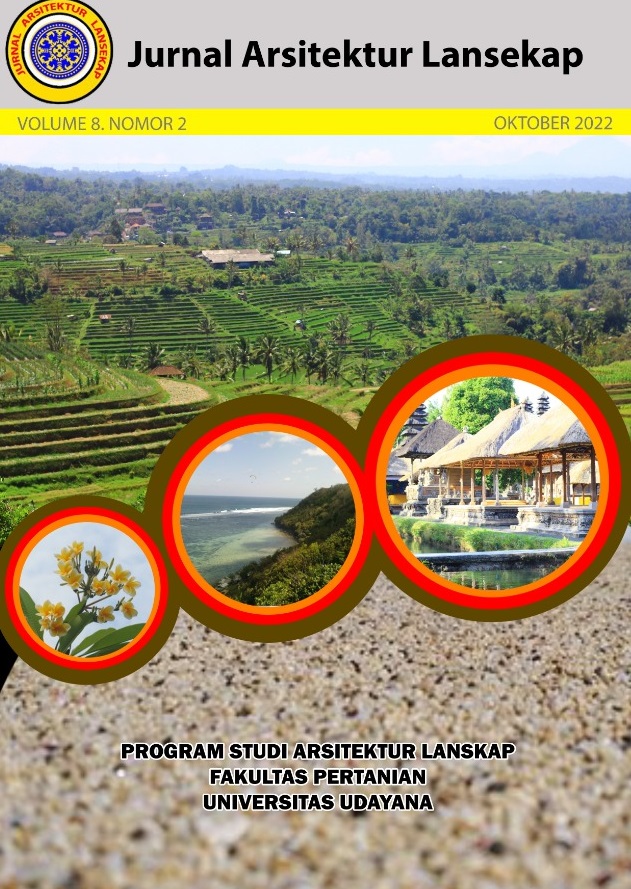Analisis ketersediaan ruang terbuka hijau di Kota Tangerang Selatan
Abstract
The need for land for urban development has an impact on changes in land use and the availability of green open spaces in urban areas. The increase in population from outside the area to urban areas will make the land in urban areas narrower and trigger a reduction in green open space. This study aims to determine the level of availability of green open space in the city of South Tangerang. The approach used in this research is a quantitative descriptive approach, namely field observation and field check, the research object of all green open spaces in the city of South Tangerang and data analysis using a geographic application system (GIS). The results showed that the change in green open space during the period 2010 to 2020 in the city of South Tangerang was 1,847 ha. The area of ??green open space available in South Tangerang City in 2020 based on the area is 4,224 ha. The area requirement for green open space required in South Tangerang City based on the area is 4,945 ha. The city of South Tangerang is still experiencing a lack of green open space of 721 ha.
Downloads
References
Arsandrie, Y., Widayanti, E. (2018). Perhitungan Ruang Terbuka Hijau Di Kecamatan Kartasura Sukoharjo Berdasarkan Luas Wilayah, Jumlah Penduduk, Dan Kebutuhan O2. Sinektika Jurnal Arsitektur. 15(2): 93-98.
Badan Pusat Statistik Kota Tangerang Selatan. 2020. Kota Tangerang Selatan Dalam Angka 2020. Available online at: www. Kota Kota Tangerang Selatan.bps.go.id (diakses 22 April 2021).
Chang, J., Qu, Z., Xu, R., Pan, K., Xu, B., Min, Y., ... Ge, Y. (2017). Assessing the ecosystemservices provided by urban green spaces along urban center-edge gradients. Scientific Reports, 7, 11226.
Hasriyanti, N., Zulestari, A. & Ruslan, I. (2020). Perubahan Pemanfaatan Lahan dan Faktor yang Mempengaruhi terhadap Permukiman di Koridor Ambawang. Tataloka, 22(1): 94-106. https://doi.org/10.14710/tataloka.22.1.94-107.
Hosaka, T., & Numata, S. (2016). Spatiotemporal dynamics of urban green spaces and human–wildlife conflicts in Tokyo. Scientific Reports, 6, 30911.
Li, F., Sutton, P. C., Anderson, S. J., & Nouri, H. (2017). Planning green space in Adelaide city: Enlightenment from green space system planning of Fuzhou city (2015–2020). Australian Planner, 54, 126–133.
Li, F., Sutton, P., & Nouri, H. (2018). Planning green space for climate change adaptation and mitigation: A review of green space in the central city of Beijing. Urban and Regional Planning, 3, 55–63.
Palmer, L. (2018). Urban agriculture growth in US cities. Nature Sustainability, 1, 5–7.
Khasanah, R. A., Priyatmono, A. F. 2018. Studi Kecenderungan Perubahan Ruang Terbuka Hijau Di Kampung Mangkunegaran Surakarta. Sinektika. 15(1) : 34-39.
Rottle, N. D. (2015). Developing a Regional Open Space Strategy (ROSS) for Central Puget Sound, Washington State, USA. ELSEVIER, 62(2015), 133–138. https://doi.org/10.1016/j.envsci.2016.02.016.
Sandstorm UG, Angelstam P, Mikusinski G. (2006). Ecological diversity of birds in relation to the structure of urban green space. Landscape and Urban Planning, 77:39–53.
Setyan. W., Sitorus, S.R.P., Panuju, D.R.( 2017). Analisis Ruang Terbuka Hijau Dan Kecukupannya Di Kota Depok. Buletin Tanah dan Lahan, 1 (1): 121-127.
Strohbach MW, Lerman SB, Warren PS. (2013). Are small greening areas enhancing bird diversity? Insights from community-driven greening projects in Boston. Landscape and Urban Planning, 114:69-79.
Departemen Pekerjaan Umum. (2008). Peraturan Menteri Pekerjaan Umum Nomor 05/PRT/M/2008 tentang Pedoman Penyediaan dan Pemanfaatan Ruang Terbuka Hijau di Kawasan Perkotaan. Jakarta (ID). Departemen Pekerjaan Umum.
Pemerintah Republik Indonesia. (2007). Undang-Undang Nomor 26 Tahun 2007 tentang Penataan Ruang. Jakarta (ID): Sekretariat NegaraRepublik Indonesia.
Van den Bosch, M., & Nieuwenhuijsen, M. (2017). No time to lose – Green the cities now. Environment International, 99, 343–350.

This work is licensed under a Creative Commons Attribution-ShareAlike 4.0 International License.
An author who publishes in the Jurnal Arsitektur Lansekap (JAL) agrees to the following terms:
- Author retains the copyright and grants the journal the right of first publication of the work simultaneously licensed under the Creative Commons Attribution-ShareAlike 4.0 License that allows others to share the work with an acknowledgement of the work's authorship and initial publication in this journal
- Author is able to enter into separate, additional contractual arrangements for the non-exclusive distribution of the journal's published version of the work (e.g., post it to an institutional repository or publish it in a book) with the acknowledgement of its initial publication in this journal.
- Author is permitted and encouraged to post his/her work online (e.g., in institutional repositories or on their website) prior to and during the submission process, as it can lead to productive exchanges, as well as earlier and greater citation of the published work (See The Effect of Open Access).
Read more about the Creative Commons Attribution-ShareAlike 4.0 Licence here: https://creativecommons.org/licenses/by-sa/4.0/.







